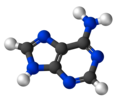
Back أدينين Arabic Adenin Azerbaijani آدنین AZB Адэнін Byelorussian Аденин Bulgarian অ্যাডেনিন Bengali/Bangla ཨེ་ཌི་ནིན། Tibetan Adenin Breton Adenin BS Adenina Catalan
 | |||
| |||
| Names | |||
|---|---|---|---|
| Preferred IUPAC name
9H-Purin-6-amine | |||
| Other names
6-Aminopurine
| |||
| Identifiers | |||
3D model (JSmol)
|
|||
| 608603 | |||
| ChEBI | |||
| ChEMBL | |||
| ChemSpider | |||
| DrugBank | |||
| ECHA InfoCard | 100.000.724 | ||
| EC Number |
| ||
| 3903 | |||
| KEGG | |||
PubChem CID
|
|||
| RTECS number |
| ||
| UNII | |||
CompTox Dashboard (EPA)
|
|||
| |||
| |||
| Properties | |||
| C5H5N5 | |||
| Molar mass | 135.13 g/mol | ||
| Appearance | white to light yellow, crystalline | ||
| Density | 1.6 g/cm3 (calculated) | ||
| Melting point | 360 to 365 °C (680 to 689 °F; 633 to 638 K) decomposes | ||
| 0.103 g/100 mL | |||
| Solubility | negligible in ethanol, soluble in hot water and/or aqua ammonia | ||
| Acidity (pKa) | 4.15 (secondary), 9.80 (primary)[1] | ||
| Thermochemistry | |||
Heat capacity (C)
|
147.0 J/(K·mol) | ||
Std enthalpy of
formation (ΔfH⦵298) |
96.9 kJ/mol | ||
| Hazards | |||
| Lethal dose or concentration (LD, LC): | |||
LD50 (median dose)
|
227 mg/kg (rat, oral) | ||
| Safety data sheet (SDS) | MSDS | ||
Except where otherwise noted, data are given for materials in their standard state (at 25 °C [77 °F], 100 kPa).
| |||
Adenine (/ˈædɪniːn/, /ˈædɪnɪn/) (symbol A or Ade) is a purine nucleotide base. It is one of the nucleobases in the nucleic acids, DNA and RNA. The shape of adenine is complementary to either thymine in DNA or uracil in RNA. In cells adenine, as an independent molecule, is rare. It is almost always covalently bound to become a part of a larger biomolecule.
Adenine has a central role in cellular respiration. It is part of adenosine triphosphate which provides the energy that drives and supports most activities in living cells, such as protein synthesis, chemical synthesis, muscle contraction, and nerve impulse propagation.[2] In respiration it also participates as part of the cofactors nicotinamide adenine dinucleotide, flavin adenine dinucleotide, and Coenzyme A.
It is also part of adenosine, adenosine monophosphate, cyclic adenosine monophosphate, adenosine diphosphate, and S-adenosylmethionine.
- ^ Dawson, R.M.C., et al., Data for Biochemical Research, Oxford, Clarendon Press, 1959.
- ^ Dunn, Jacob; Grider, Michael H. (2023). "Physiology, Adenosine Triphosphate". StatPearls. StatPearls Publishing. PMID 31985968. Retrieved 13 November 2023.
© MMXXIII Rich X Search. We shall prevail. All rights reserved. Rich X Search

